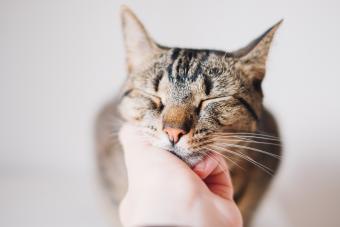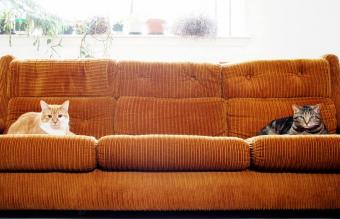
In order to provide your cat with the healthiest, longest life possible, it's important to keep them safe. Unfortunately, many unassuming elements can pose a threat to your cat -- both indoors and out. Implement these cat safety suggestions from an expert to ensure your feline friend stays out of harm's way.
Toys That Can Pose Safety Hazards
Even though the iconic image of a cat playing with a ball of yarn might seem innocent enough, these types of toys are not safe for cats. Toys that your cat can potentially swallow or chew are not good choices. Do not allow your cat to play with these dangerous items.

- Hair ties
- Rubber bands
- String, twine, or yarn
- Toys with feathers
- Rope toys
- Toys with small pieces that can come off like pompoms
If a cat eats any of these items, they could become stuck in their stomach or intestines and create a blockage. Long material, such as string or yarn, poses an even greater threat because these can create linear foreign bodies. If your cat simply loves a particular toy, it should be safe to offer them closely supervised playtime with it. However, if they make attempts to eat or chew on the toy, be sure to remove it right away.
Outdoor Dangers Outweigh Indoor
Statistically, an average indoor cat lives around 10 to 15 years, whereas an average outdoor cat will only reach 2 to 5 years old. This difference in lifespan is so significant and alarming, yet it really comes down to safety. Outdoor cats are simply at higher risk for disease, injury, and environmental hazards compared to those kept indoors.

Some of the biggest outdoor hazards include the following.
- Vehicles
- Attacks from cats, dogs, and other animals
- Abuse from cruel people
- Falls from high trees or buildings
- Infectious viruses from other cats (FeLV, FIV, feline panleukopenia)
- Infectious viruses from wildlife (rabies, leptospirosis)
- Parasitic diseases (intestinal parasites, tick-borne disease, plague from fleas)
- Toxins or poisons (rodenticides, antifreeze)
Given these avoidable dangers, confining a cat to the indoors is the best way to provide them with safety. Lori Soard, freelance pet writer, agrees, stating, "It really is not safe for a cat to be outdoors, and I recommend that you keep your cat indoors at all times. Outdoors, your cat will be in danger from predators such as roaming dogs, coyotes, and other cats that might attack them and spread fatal diseases such as cat flu."
This isn't just a recommendation that she makes based on research, but one that she's, unfortunately, experienced personally. "I learned this lesson the hard way from experience and from losing a cat to feline leukemia, which was a horrid, painful, and violent death for my cat." Soard now keeps her own cats inside in order to keep them safe.
That doesn't necessarily mean your cat will have to live their entire life without experiencing the great outdoors. Soard offers, "One solution would be to take them outdoors when you will be there to monitor them, either on a leash and harness or in a cat run." This way, your cat can get a taste of nature without the danger.
Outdoor Cat Safety Tips
Although keeping your cat indoors in the best way to keep them safe, some owners find it's impossible to confine your cat to the house. If your feline insists on roaming outside, there are several ways you can increase their level of safety.
- Ensure They're Vaccinated. Outdoor cats can interact with other felines as well as rabies-carrying wildlife. To keep your cat safe from contracting fatal viruses, ensure they're up to date on necessary vaccines. Some vaccinations are due annually, whereas others only need to be given every three years. Use a vaccine schedule to ensure your cat stays current and protected.
- Keep Nails Untrimmed. This tip might sound odd, considering the opposite is usually recommended for indoor cats, but cats who roam outdoors need their claws for protection. Sharp claws are necessary if they're chased by an animal and need to run up a tree. And should they encounter a threat and have to put up a fight, they can protect themselves with their nails.
- Upgrade Your Pet Door. If you have a pet door that your cat uses to come and go from the home, you can consider upgrading to an electronic door. Soard suggests this for owners who are not able to keep their cats completely indoors. She explains, "The receiver is in the collar and the only animals allowed in or out are those with the collar. Think of it like an automatic door at a retail store, only you must have a pass to go in and out." This will allow you to keep stray animals and wildlife out of your home and could serve as a way to give your cat a curfew by prohibiting exit after a certain time.

Indoor Cat Safety Tips
Indoor cats aren't free of risk, as there are still numerous dangers within the home. If you keep your pet inside, be sure to implement these indoor cat safety measures.
- Make Sure They Have ID. Current identification is important for all cats, regardless of whether they're supposed to remain indoors or are allowed to roam. There's always a possibility that a sly cat could slip out the door when you least expect it. And if they're picked up by animal control or a neighbor, a visible ID tag will help you become reunited. Breakaway collars are often the safest choice because they prevent strangulation. Ideally, your cat should also have a microchip placed under their skin should they lose their collar, too.
- Keep Toxins Away. Indoor cats only have access to whatever you bring into the home, so be sure you're aware of potential toxins. Certain plants, medications, cleaning products, and electrical cords can severely harm or even kill a cat. Naturally, if you must keep items like medications in the house, ensure they're put away in a secure cupboard. There are numerous solutions to protect your cat from cords.
- Load Washer and Dryers Carefully. Cats love warm laundry. And what's warmer than laundry? The dryer. It's not unheard of for a cat to rest unassumingly in an open appliance before being locked in and run through a cycle. It's also possible to toss a heap of clothes into the washer without realizing that your cat was snuggled within the hamper. Unfortunately, the outcome in these cases is typically not a good one. Always be sure to check the washer and dryer first, then carefully load garments in individually to avoid this unsafe situation.
Keep Your Cat Safe With Regular Check Ups
Cats are incredibly stoic creatures and often won't show you any obvious signs of illness until they're very sick. This is a survival instinct that they developed in the wild to avoid being picked off by predators. But it makes your role as their caretaker that much more challenging, which is why preventive medicine is so important.

Your veterinarian is skillfully trained to detect even the most subtle signs of illness in cats. Routine blood work, urinalysis, and other diagnostics can also reveal any hidden abnormalities occurring within vital organs. By identifying and treating any conditions early on, especially those like kidney disease or diabetes, you can save your cat unnecessary discomfort and likely save yourself money in the long run.
Increase Your Cat's Safety
Although it's impossible to eliminate any risk of harm or danger, there are certainly ways to increase your cat's safety. If your cat is still engaging in unsafe behaviors, such as scooting outside any chance they get or chewing on cords despite preventive measures, you may want to consider consulting with your vet or a behaviorist.







